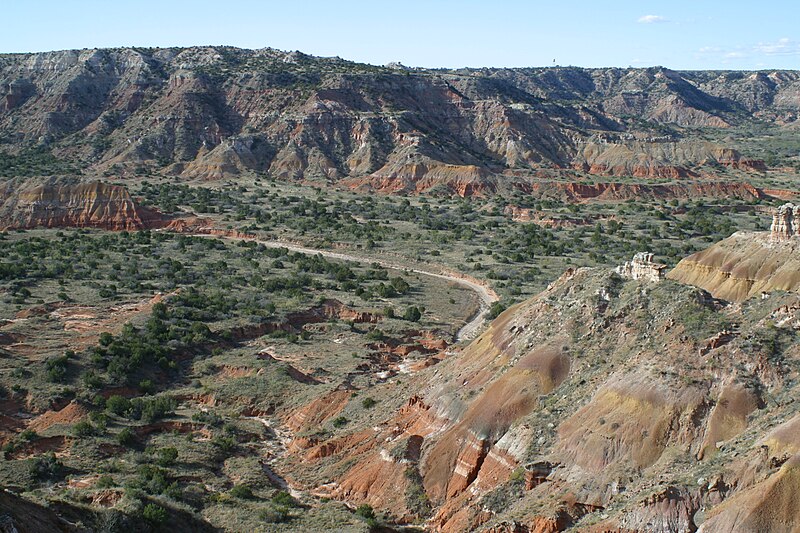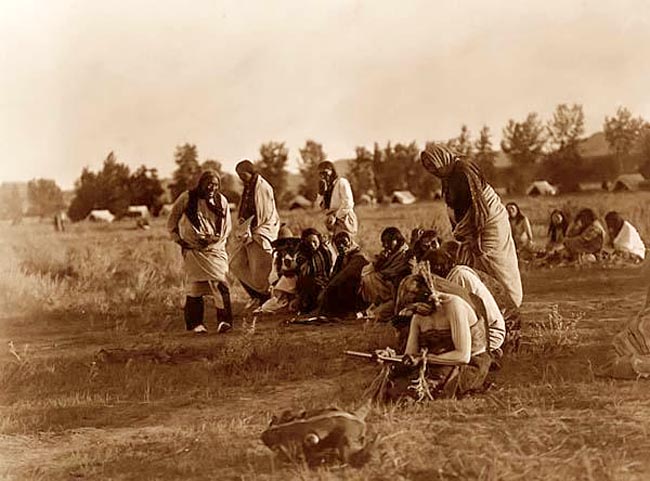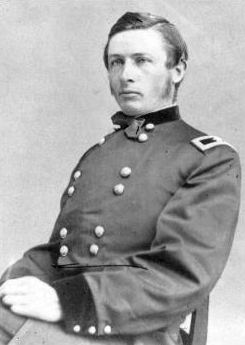 Ever Ever since the summer of 1874 the Comanches, Cheyenne
Ever Ever since the summer of 1874 the Comanches, Cheyenne  and Kiowas had sought refuge in Palo Duro Canyon in the Texas panhandle. There they had been stockpiling food and supplies for the winter. Colonel Ranald S. Mackenzie,
and Kiowas had sought refuge in Palo Duro Canyon in the Texas panhandle. There they had been stockpiling food and supplies for the winter. Colonel Ranald S. Mackenzie, leading the 4th U.S. Cavalry, moved up from the south intending to trap the whole force in their Palo Duro Canyon holdout.
leading the 4th U.S. Cavalry, moved up from the south intending to trap the whole force in their Palo Duro Canyon holdout. Fighting several skirmishes with Comanche warriors along the way Mackenzie reached Palo Duro in late September.below comanches
Fighting several skirmishes with Comanche warriors along the way Mackenzie reached Palo Duro in late September.below comanches
Early in the morning of September 28, one of Mackenzie's scouts found the Indian camp and notified the colonel. Mackenzie brought the whole regiment to the edge of the canyon and planned a surprise attack. Comanche Chief Red Warbonnet

According to tribal history, Red Warbonnet was a Kiowa. Red Warbonnet (I) (Tanguadal) died in 1849, according to the Kiowa calendar of a cholera epidemic. Red Warbonnet II pronounced in Kiowa as Tan-guadal was the hereditary owner of the arrow lance (zebat) and owner of the morning star tipi of the Kiowa Tribe (Elks band) in the Kiowa Sun Dance circle. Red Warbonnet's niece, Addlegamah, was the mother of Edgar Keahbone (K'yaitah-kebonemah) who inherited the arrow lance. Edgar kept the arrow lance in his warrior society, Ohumah Lodge until his death in 1951. His wife, Sendehmah, passed the arrow lance down to his eldest son, Mark. Male descendants of the family have replicated the arrow lance and carry it today at Ohumah Lodge, a Kiowa warrior society still in existence today and is held in July of each year.
Prior to the Battle of Palo Duro Canyon,
 the canyon was a stronghold of the Kiowa Tribe and often a resting place on a journey or war path. The Kiowa people knew the canyon inside and out thus explaining their ability to resist capture by McKenzie for such a long period of time. Poor Buffalo, a Kiowa, led his people to the canyon to escape reservation life. Poor Buffalo's band was the last of the Kiowa's to be taken in.discovered the U.S. soldiers and fired off a warning shot, but was quickly killed. Mackenzie's troopers were unable to find a suitable path down, so instead plunged straight down the steep canyon cliffs. Mackenzie first hit Chief Lone Wolf's Kiowa
the canyon was a stronghold of the Kiowa Tribe and often a resting place on a journey or war path. The Kiowa people knew the canyon inside and out thus explaining their ability to resist capture by McKenzie for such a long period of time. Poor Buffalo, a Kiowa, led his people to the canyon to escape reservation life. Poor Buffalo's band was the last of the Kiowa's to be taken in.discovered the U.S. soldiers and fired off a warning shot, but was quickly killed. Mackenzie's troopers were unable to find a suitable path down, so instead plunged straight down the steep canyon cliffs. Mackenzie first hit Chief Lone Wolf's Kiowa  camp and routed it. Chiefs Poor Buffalo and Iron Jacket managed to effect some resistance but since the camps were so spread out over the canyon floor, a unified resistance was impossible. Many of the Indians fled leaving behind their possessions and headed for the open plains. Few warriors remained sniping at the soldiers but by nightfall, the canyon belonged to Mackenzie and the villages were destroyed.
camp and routed it. Chiefs Poor Buffalo and Iron Jacket managed to effect some resistance but since the camps were so spread out over the canyon floor, a unified resistance was impossible. Many of the Indians fled leaving behind their possessions and headed for the open plains. Few warriors remained sniping at the soldiers but by nightfall, the canyon belonged to Mackenzie and the villages were destroyed.The loss of the Palo Duro camp meant the loss of the Indians' safe haven and all their winter supplies. Some horses fled with the Indians onto the plains but Mackenzie was able to capture 1,400 ponies. The horses Mackenzie did not need were slaughtered to prevent them from falling into the hands of the Indians. Casualties were light in the engagement since it had been a complete rout, but without sufficient mounts or winter supplies the tribes could not hold out over the winter and many returned to the Fort Sill
 reservation by November 1874. Lone Wolf's Kiowas did not return until February 1875.
reservation by November 1874. Lone Wolf's Kiowas did not return until February 1875.
No comments:
Post a Comment